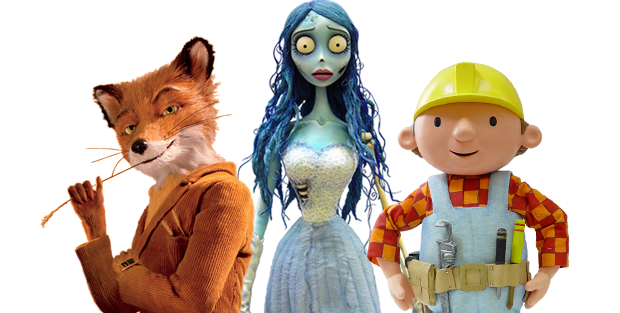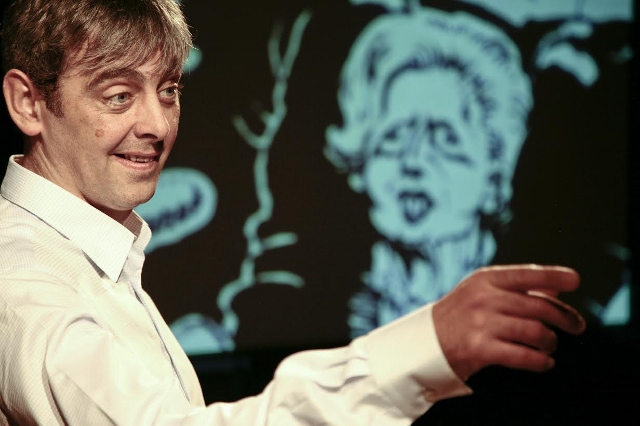If you wander into quiet, leafy Oldfield Brow just outside Altrincham, you’ll find many things that you might reasonably expect to see: a little church, a Post Office, a couple of takeaways and a butty shop. But then you’ll come across something you wouldn’t expect at all: the headquarters of the world-beating stop-motion animation studio, Mackinnon and Saunders.
Ian Mackinnon and Pete Saunders first met at the legendary Cosgrove Hall Productions in Chorlton-cum-Hardy, working as animators on projects such as Wind in the Willows and The Pied Piper of Hamelin. Speaking exclusively to Northern Soul, Saunders says: “I was born and bred in Rochdale and I went to Chetham’s School before it became a music school. Then I went to West Surrey College of Art and Design down in Guildford. I did a diploma in animation there, and then I was looking to get work in London but Brian Cosgrove had been down to the degree show that year.”
Cosgrove spotted the potential in Saunders’ work, and offered him six weeks work on a stop-motion project at Cosgrove Hall.
“I thought, it’ll be a little bit of money and I’ll go travelling after that. And then six weeks work extended out into about 15 years. It was a really, truly, great company to work for. I joined the company a year after it started and so there was only a small handful of people there, maybe about nine or ten people, but over the years it grew to about 130, 140 people.”
At various times this team included future music stars Bernard Sumner (whose duties included colouring in backdrops for Jamie and the Magic Torch) and John Squire (who made props for Wind in the Willows). Saunders’ sister worked there occasionally, too, and she pointed Saunders in the direction of a story in the local Warrington newspaper.
 “She spotted an article about this teenager who made these beautiful puppets in his spare time in the family garage, and she said, ‘Pete, have you seen this? Maybe it’d be worth taking a look at him’. So we got him in, and he didn’t have a portfolio of stuff but he did have photographs of the work that he’d been doing and they were incredible, absolutely superb.” The teenager in question, Ian Mackinnon, was duly taken on by Cosgrove Hall’s puppet department.
“She spotted an article about this teenager who made these beautiful puppets in his spare time in the family garage, and she said, ‘Pete, have you seen this? Maybe it’d be worth taking a look at him’. So we got him in, and he didn’t have a portfolio of stuff but he did have photographs of the work that he’d been doing and they were incredible, absolutely superb.” The teenager in question, Ian Mackinnon, was duly taken on by Cosgrove Hall’s puppet department.
For most of its lifespan, Cosgrove Hall was bankrolled by Thames Television but, in 1993, Thames lost its ITV franchise and shut the company down. It re-emerged with new owners, but only after a steady wave of staff redundancies.
“That’s when Ian and myself decided to set up our own company. Had Cosgrove Hall continued to exist, we’d still be there to this day. It was such a great company to work for and Mark Hall and Brian Cosgrove were such great bosses to work under. There was absolutely no reason why we should have looked elsewhere, really. So we never meant to set up our own company, it was only force of circumstance.”
Initially, Mackinnon and Saunders rented out space in the Cosgrove Hall building until they purchased their current premises. More than 20 years later, the company is recognised as one of the leaders in its field.
If you’ve ever seen Rastamouse, Bob the Builder, Pingu, James and the Giant Peach, the revived Clangers or Wes Anderson’s Fantastic Mr Fox, you’ll have witnessed their puppet-making wizardry. In particular, they’ve established a long working relationship with director Tim Burton. Back at the end of the 90s, the company was engaged to work on puppet designs for Burton’s Mars Attacks! The original plan was for the belligerent Martians to be rendered in stop-motion, but in the event the studio changed tack and used Mackinnon and Saunders’ designs as the basis for computer-generated imagery instead. It was a disappointment, but ultimately there were no hard feelings.
“We had to be philosophical about it,” Saunders shrugs. “We got nine months of work out of it, we’d worked in Los Angeles. You could pull up the shutter door at the back of the building and you could see the Hollywood sign. And it’s like, blimey, we’re two puppet makers, one from Rochdale, one from Warrington, and you never expect that you’re going to be working in Hollywood. So we were incredibly grateful and we made a bit of money out of it, but most importantly of all we got to meet Tim and establish a relationship with him.” 
It was a relationship which soon bore fruit.
“The year after Mars Attacks! came out, Tim said, ‘I’ve got this really lovely project called Corpse Bride and I’d love you guys to be involved’. We were cock-a-hoop about that. I mean, it was six years before that was given the go-ahead, but he kept true to his word.”
In turn, 2005’s Corpse Bride lead to 2012’s Frankenweenie, and Saunders remains full of admiration for Burton and his hands-on enthusiasm for animation.
“The lovely thing about working with Tim is that he’s a huge stop-motion fan. With Corpse Bride he would come up whenever he could to see the progress of things. Considering he’s an A-lister film director, he’d invariably come up by himself, stay overnight and come in and see what was going on. You really got the sense that he was excited by the construction and the kind of evolution of the characters. He was so enthusiastic and he’d talk to everybody. He wouldn’t just talk to me and Ian, he’d go round the workshop and say, ‘hi guys, how are you doing? that’s great work’. It was like a real bolt of energy coming in. People would really, really look forward to his visits. These are pretty full-on, these big projects, and Tim would come up every so often and get everybody really charged up and motivated. He’s a great joy to work with.”
 A recent development for the company has been the creation of a digital studio wing – that is, embracing the world of computer animation. Back in the day, this would have seemed an unlikely development.
A recent development for the company has been the creation of a digital studio wing – that is, embracing the world of computer animation. Back in the day, this would have seemed an unlikely development.
“Ian and myself had only been in business for two years and we were still at that time based in the Cosgrove Hall building, and some people from London involved with computer graphics came round as guests of Cosgrove Hall. They came round our puppet-making company and one of them rather gleefully said that we’d be out of business in two years. He said it’s all going to go to CG. Well, I’m pleased to say that that’s over 20 years ago now and we’re still here. We’re getting approached to work on projects from literally all over the world now, which is great.”
The digital division was established at the request of a client, Komixx Entertainment, in order to make the children’s series Wanda and the Alien. Now, that team can animate character designs for puppet projects, too.
Saunders says: “You kind of think, well, why did we never do that before? I would hate people to think that Ian and myself are some sort of Luddites who would rather that computer graphics don’t exist. I mean, you can’t see the films of Pixar and not think that there’s true genius at work with those, from every aspect: from a storytelling point of view, from a design point of view, from a computer graphic point of view, the aesthetic of it. They’ve not made a duff film yet and some of the films are absolutely without equal, I think. So we love digital as well as 3D, it’s just that we happen to have grown up doing this particular type of work.”
In the long term, then, there’s no reason why the two can’t co-exist. “Stop-motion has a kind of physicality to it, an artisan quality. I think, well, nobody questions why you get watercolour paintings being made as well as oil paintings. It’s just that they’re different. They’re two different things and they give a different effect and they’re both valid.”
 Mackinnon and Saunders are being celebrated by the Sale Waterside arts centre in an exhibition, Puppet Masters. It runs until February and looks at the development stages of a few key puppet projects. It’s only right and proper that a major local success story should be lauded in such a fashion. With a big, thriving company to run, though, does Saunders himself still manage to get hands-on as an animator these days?
Mackinnon and Saunders are being celebrated by the Sale Waterside arts centre in an exhibition, Puppet Masters. It runs until February and looks at the development stages of a few key puppet projects. It’s only right and proper that a major local success story should be lauded in such a fashion. With a big, thriving company to run, though, does Saunders himself still manage to get hands-on as an animator these days?
“Ah, I’d love to say yes,” he sighs. “Up until a couple of years ago, Ian and myself did have a workbench next to each other in the main workshop, and we do love to get stuck in because we started as puppet makers. That’s where I feel most comfortable. But we employ on a regular basis anything between 65 to 90 people now and our time is getting more and more taken up with administrative issues to do with the company. We don’t necessarily have the same time to become hands-on.”
And yet, Saunders insists that it’s still the same thrill whenever he does get involved.
“Oh, yes! The trouble is, when you’ve been sat behind a computer for the best part of a year or more, going back in the workshop, you’re like the trainee or the graduate who’s just joined. It all feels a little bit foreign, but you soon get back into it. I feel far happier with a saw and hammer in my hands than I do sat typing away at a computer.”
 Puppet Masters: Celebrating Animation exhibition runs at Sale Waterside until February 27, 2016: https://watersideartscentre.co.uk/whats-on/1711-puppet-masters-celebrating-animation/
Puppet Masters: Celebrating Animation exhibition runs at Sale Waterside until February 27, 2016: https://watersideartscentre.co.uk/whats-on/1711-puppet-masters-celebrating-animation/
Pete Saunders will be present with other celebrated animators for a special day event, Meet the Puppet Masters, at Sale Waterside on November 7, 2015: https://watersideartscentre.co.uk/whats-on/1713-meet-the-puppet-masters/











